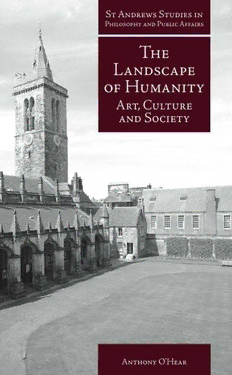
The Landscape of Humanity: Art, Culture and Society PDF
Preview The Landscape of Humanity: Art, Culture and Society
Contents Preface Introduction: The Landscape of Humanity Section 1: Art 1. Evolution and Aesthetics 2. Historicism and Architectural Knowledge 3. Prospects for Beauty 4. Kantian Distinterestedness 5. The real or the Real? Chardin or Rothko? Section 2: Culture 6. Two Cultures Revisited 7. Art and Censorship 8. To Swim with Strong Strokes in the Lake of Antique Poetry 9. Art and Technology: An Old Tension 10. Science and Religion Section 3: Politics 11. Democracy and Openness 12. Hayek and Popper: The Road to Serfdom and The Open Society 13. Criticism and Tradition in Popper, Oakeshott and Hayek 14. The Open Society Revisited 15. Britain and Europe: An Oakeshottian Meditation The Landscape of Humanity Art,CultureandSociety AnthonyO’Hear IMPRINTACADEMIC Copyright © Anthony O’Hear, 2008 The moral rights of the authors have been asserted. No part of any contribution may be reproduced in any form without permission, except for the quotation of brief passages in criticism and discussion. Originally published in the UK by Imprint Academic, PO Box 200, Exeter EX5 5YX, UK Originally published in the USA by Imprint Academic, Philosophy Documentation Center PO Box 7147, Charlottesville, VA 22906-7147, USA Digital edition converted and distributed in 2011 by Andrews UK Limited www.andrewsuk.com Cover Photograph: St Salvator’s Quadrangle, St Andrews by Peter Adamson from the University of St Andrews collection ToTricia,Natasha,JacobandThea adfamiliammeamamandamamatamque Preface The fifteen essays inthis bookhavebeen written overaperiod of years,fromthe early1990stothe timeofpublication(2008). Most have already been published in some form, though all have been revisedtoagreaterorlesserextentforthisvolume.Thisistoreduce repetition and inconsistency as far as possible, and also to take account of developments in my thinking where these bear on the topicsunderdiscussion. In the order in which they appear in this volume, the original placesofpublicationareasfollows: ‘EvolutionandAesthetics’ inBiology,EvolutionandLife,editedbyA.O’Hear,CambridgeUniversity Press,2005,pp155–76. ‘HistoricismandArchitecturalKnowledge’ inPhilosophy,68,1993,pp127–44. ‘ProspectsforBeauty’ in Philosophy at the New Millennium, edited by A. O’Hear, Cambridge UniversityPress,pp175–91. ‘KantianDisinterestedness’ notpreviouslypublished;partofapaperontheapproachesofDürerand CranachtotheillustrationoftheBookofRevelation,writtenjointlywith Natasha O’Hear, and presented to the D Society at the University of CambridgeinFebruary2007. ‘TherealortheReal?ChardinorRothko?’ in Philosophy,Religionand theSpiritualLifeedited by MichaelMcGhee, CambridgeUniversityPress,1992,pp47–58. ‘TwoCulturesRevisited’ inVerstehenandHumaneUnderstanding,editedbyA.O’Hear,Cambridge UniversityPress,1997,pp1–17. ‘ArtandCensorship’ inPhilosophy,66,1991,pp512–16. viii The Landscape ofHumanity ‘ToSwimwithStrongStrokesintheLakeofAntiquePoetry’ lecturegivenatthePrinceofWales’EducationalSummerSchool,Buxton, Derbyshire,June27th,2004,andpublishedinaslightlydifferentversion astheEpiloguetotheauthor’sTheGreatBooks, Icon Books, Thriplow, Cambridge,2007,pp433–49. ‘ArtandTechnology:anOldTension’ in Philosophy and Technology, edited by Roger Fellows, Cambridge UniversityPress,1995,pp143–58. ‘ScienceandReligion’ inTheBritishJournalforthePhilosophyofScience,44,1993,pp505–16. ‘DemocracyandOpenness’ inPoliticalPhilosophy,editedbyA.O’Hear,CambridgeUniversityPress, 2006,pp39–56. ‘HayekandPopper:TheRoadtoSerfdomandTheOpenSociety’ inTheCambridgeCompaniontoHayek,editedbyEdwardFeser,Cambridge UniversityPress,2006,pp123–47. ‘CriticismandTraditioninPopper,OakeshottandHayek’ inTheJournalofAppliedPhilosophy,9,1992,pp65–75. ‘TheOpenSocietyRevisited’ inKarlPopper:CriticalAppraisals,editedbyPhilipCattonandGraham Macdonald,Routledge,Abingdon,2004,pp65–75. ‘BritainandEurope:anOakeshottianMeditation’ notpreviouslypublished. Iwouldliketothankthevariouspublishersconcernedforpermis- siontoreprintpreviouslypublishedmaterialinthisvolume. IwouldalsoliketothankProfessorJohnHaldane,GeneralEditor oftheStAndrewsStudiesinPhilosophyandPublicAffairs,whoseidea the volume was, both for his faith in the project and also for our manyconversationsovertheyears. AnthonyO’Hear April2008 Introduction The Landscape of Humanity Thefifteenessaysinthisbookcollectivelydevelopaconceptionof humanculture,whichishumaneandtraditionalist,andwhichalso sees within human experience pointers to a world beyond the material.Thefirstfiveessaysfocusontheaestheticingeneralandon beautyinparticular,inanattempt touncoverwhatisinvolvedin bothnotions,andhowontheonehandtheyrelatetoourembodied existence,andhowontheothertheyevokeintimationsoftranscen- dence.Thesecondsetoffiveessaysalltouchonhumancultureina broadersense,byexploringwithinculturethespecificplacesofsci- ence, ofreligion, and ofwhat we mightthink ofasthe expressive arts. We look at the place within a culture of a tradition of great booksandalsooftechnologyinrelationtoartisticexpression,aswell asconsideringreasonswhycensorshipmightbeseenasnecessaryin relationtoart.Thefinalselectionoffiveessaysfocusesonpolitics, andparticularlyonthepotentialtensionsbetweencallsfordemo- craticopennessinasocietyandtheneedinanyviablesocietyfora settledbackgroundoftradition.Thesetensionsareexploredinrela- tiontomulti-culturalismandtotheEuropeanfederalistproject. Art Inthefirstchapter,Iconsidertherelationbetweenbiologicalevolu- tionandouraestheticsense.Assuggestedatvariouspointsinthis collection,oneofthetasksofhumanexistenceispreciselytoexperi- encetheworldthroughoursenseandsensibility,toarticulateand reflectonthatexperience,givingvoiceandexpressiontowhatwe perceiveandexperience.Ourembodimentisthestartingpointofall ouraestheticendeavours,andthepointtowhichtheywillalways return.Asintegraltoourembodiment,wehaveanaturewhichwe shareinpartwithanimals,andthisincludesrespondingfavourably, 2 The Landscape ofHumanity perhapsevenaestheticallytocertaintypesofstimuli.Someofthis maybeduetoeventsandadaptationswaybackinourevolutionary history.ButexaminingtheattemptsofDarwinandotherstofindconti- nuitiesbetweenouraestheticsenseandanimalresponsesleadsusto seethathumanaestheticresponsesgofarbeyondanythingdiscernible intheanimalkingdom.Weappreciatebeautyforitsownsake,andwe characteristicallyseeinitintimationsofaworldbeyondthematerial. Ifouraestheticsenseandtheworkswhichareproducedbyusin responsetoittranscendthebiological,aretheyfreeofhistoricaland sociologicaldeterminism.Asworksofthehumanspirit,weshould notseeartisticactivityandcreationindeterministicterms,anymore thantherestofhistory,orsoIargueinthesecondchapter.Weshould resistattemptsofarttheoriststoinsistthatashistoryismovingina particulardirectionand progresshasitsownineluctable demands, onlyonestyleorapproachisvalidataparticulartime.Artistsand architects are as free as anyone else to stand out against historical trends. Nevertheless all our creativity is rooted in tradition and in whathasemergedfromtradition,soweshouldbecautiousaboutrad- icalbreakswiththepast(especiallywhen‘progress’isinvokedtojus- tify them). This tendency is, as I argue in the chapter, particularly dangerous in architecture, which has widespread and long-lasting effects,andifitgoeswrong,thesecanbedeeplyde-humanising. Chapters3and4addressthetopicofbeauty.Muchmodernartis deliberatelyunbeautiful,andmodernwritersonartarereluctantto speakofbeautyatall.Thereasonsforthisareexamined,butmore importantthantheanalysisofthecauseistheneedtore-assertthe centralityofbeautytotheaestheticendeavour.Beautyshouldbeone of the main aims of artistic endeavour, if not the main aim. It is throughthepursuitofbeautyassomethingtobesoughtforitsown sake that art and the aesthetic evince their strongest intimations of transcendence. As these intimations spread out over the whole of humanlife,includingthemoral,thereligiousandthetrue,artcannot beconfinedinapurely‘aesthetic’realm,asKantwouldhaveitwith his doctrine of disinterestedness as a requirement of ‘pure’ beauty. TakingthedepictionsoftheBookofRevelationbyDürerandCranach respectivelyasexamples,Chapter4isacritiqueoftheKantianthesis. Inthefifthandfinalchapterinthesectiononart,Iarguethatifour particularvocationashumanbeingsistoarticulateandrespondto the world in our own particular way, then the best artists will includethosewhoattendtohumanexperienceandthethingswhich framethatexperienceandamongwhichwelive.FollowingProust,I The Landscape ofHumanity 3 takeChardintobeaparadigmcasehere,onewhoquietlyandmedi- tativelyexploresthesmallthingsofthehumanworld.Bycontrast, wipingawayallthedetailofourexperienceinanattempttogain pure,immaterialexpression,asMarkRothkoappearedtodo,may be a human and artistic cul-de-sac. There are analogies here with theologicalattemptstocutloosefromthesymbolismanddogmaof particularreligionstosetsailontheseaofundifferentiatedecumeni- cal agreement, as I suggest, a point to which we return from a differentangleattheendofthenextsection. Culture In the first chapter of the second part (Chapter 6), a distinction is drawnbetweenscienceandculturemoregenerally.Scienceprescinds from the subjective and the human, which is precisely where its strengthderives.Butthesubjectiveandthehumanaretheveryareas whichareattheheartofculture.Theyareatthecoreofthehuman world, what the phenomenologists refer to as the life world (Lebenswelt);theyarethefocusofVerstehenorofourunderstanding ourselvesandtheworldfromwithin.Whiledeploringthesuggestion thattherearetwocultures,sciencebeingatmostonepartofcultureinthe widersense,Iconsidertheextenttowhichcultureinthissenseisspecific toaparticular traditionorcommunity.Thisisacontrastwithscience, whichinaimanyway,isnotspecifictoparticularcultures,but,aswe argue,therearealsowaysinwhichwecan,culturally,reachoutbeyond theconfinesofourparticularculturaltraditionsandinheritance. Theseventhchapterfocusesonaspecificandcontroversialaspect oftherelationbetweenartandthewiderculture,thatwhichleadsto politicalandpopulistcallsforcensorship.Withoutdefendingcen- sorship,Iarguethattheadvocatesofcensorshipmayhaveamore livelysenseofthepowerandimpactofartthanthosewhoarguefor anartisticrealminsulatedfrompolitical,moralandreligiousinter- ference. Looking at the relation between the arts and culture in a widersense,Chapter8arguesfortheimportanceofthenotionofa corpusofgreatbooks,workswhichhavestoodthetestoftime,and whichshouldbetakenontheirowntermsiftheyaretobenefitus. Thenintheninthchapterwereturntotheideathatworksofartare essentiallyworksofthecreativehumanspiritandimagination,pro- ducedbybeingslivingwithinaculture.Assuch,iftheyaretosuc- ceed,theycannotbemechanicalorproducedbyacomputerorany otherdevicenotendowedwithhumanity;intheessayweshowin detail,andagainstmuchofthespiritofourage,whythisisso.
